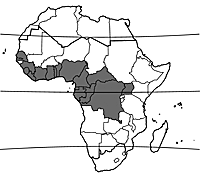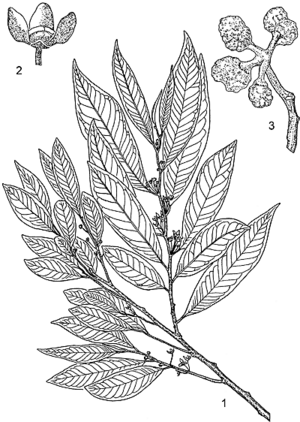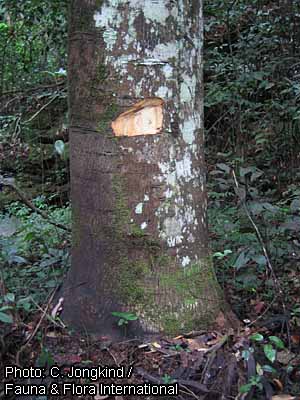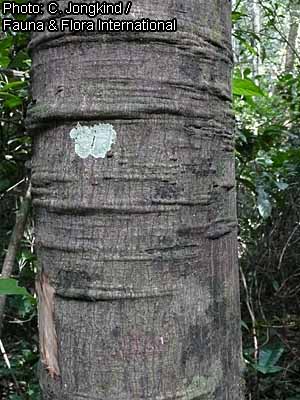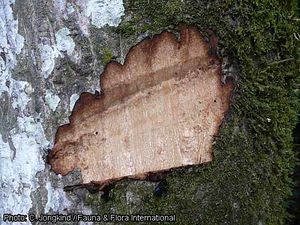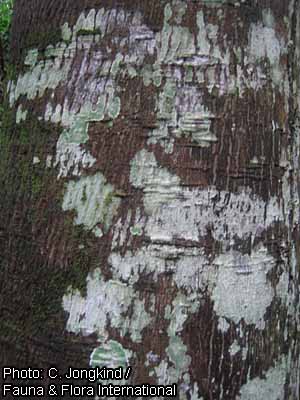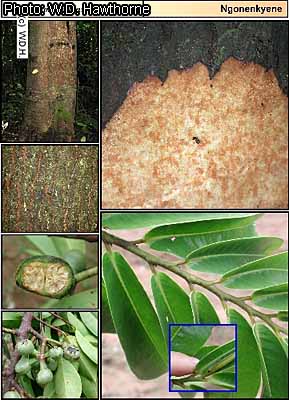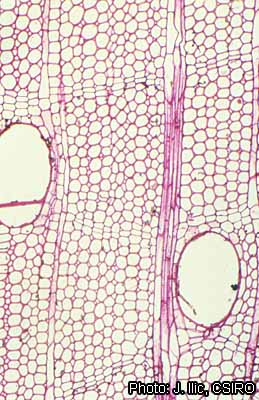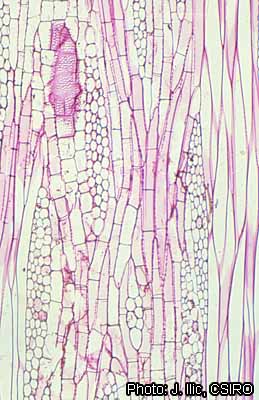Cleistopholis patens (PROTA)
Introduction |
| General importance | |
| Geographic coverage Africa | |
| Geographic coverage World | |
| Medicinal | |
| Timber | |
| Ornamental | |
| Fibre | |
Cleistopholis patens (Benth.) Engl. & Diels
- Protologue: Engl., Monogr. afrik. Pflanzen-Fam. 6: 35 (1901).
- Family: Annonaceae
- Chromosome number: 2n = 14
Origin and geographic distribution
Cleistopholis patens is widely distributed from Senegal eastward to Uganda, and southward to DR Congo and Cabinda (Angola).
Uses
The wood, known as ‘avom’, is used for joinery, door frames, roof-beams, drums, floats and canoes. It is suitable for furniture, sporting goods, boxes, crates, implements, food containers, veneer, plywood, hardboard, particle board, wood-wool and pulpwood. Tree boles are used to float heavy timber in rivers. Wood ash is sometimes used as food preservative.
The fibrous bark is used for matting, basketry, cordage and hut walls. Several plant parts are commonly used in local medicine. Bark decoctions are taken to treat stomach-ache, diarrhoea, tuberculosis, bronchitis and hepatitis. Bark pulp is applied against swellings, oedema and whitlow, and bark sap is dropped into the nose to treat headache and rubbed in to treat rickets in children. In Uganda crushed bark is used in preparations to treat malaria and measles. In Nigeria the bark is used to treat typhoid fever and bark extracts are used in the treatment of menstrual irregularities. The root bark is used as vermifuge. Leaf infusions or decoctions are administered against hepatitis, fever, trypanosomiasis and rheumatic arthritis, and as vermifuge. Roasted and ground seeds are applied against headache. Seeds have been used as beads.
Production and international trade
The wood is only used locally and not or rarely traded on the international market.
Properties
The heartwood is greyish white, sometimes with a pinkish tinge, indistinctly streaked, indistinctly demarcated from the sapwood. The grain is straight, texture coarse but even. The wood is lustrous.
It is lightweight, with a density of 290–500 kg/m³ at 12% moisture content, and rather soft. The wood air dries rapidly, but should be stacked properly to avoid degrade; the rates of shrinkage are rather high, from green to oven dry 5.0% radial and 9.6% tangential. Once dry, the wood is moderately stable in service. At 12% moisture content, the modulus of rupture is 29–38 N/mm², modulus of elasticity 6080–8230 N/mm², compression parallel to grain 38 N/mm², shear 11 N/mm² and Janka side hardness 1410 N.
The wood is easy to saw and work. It planes well and finishes smoothly. It does not split easily upon nailing and the nail-holding power is satisfactory. The wood peels well. It is not durable, being liable to fungal, termite, Lyctus and marine borer attacks. Tests showed moderate pulping characteristics for paper production.
Methanol extracts of the bark showed distinct antimicrobial activity. The steroidal fraction of the extract showed much more potent activity against Bacillus subtilis and Klebsiella pneumoniae than penicillin and chloramphenicol, the glycoside and alkaloid fractions showed significant activity against Klebsiella pneumoniae, and the saponin fraction against Salmonella typhimurium. The alkaloids eupolauridine, onychine and 3-methoxysampangine have been isolated from the bark; these compounds showed potent antifungal activity against Candida albicans. Additionally, bark extracts exhibited anthelmintic activity against Rhabditis pseudoelongata.
The essential oil from the leaves contains (E)-β-ocimene as main constituent, that from the bark myrcene, P-cymene and germacrene D, and that from the fruits linalool and (E)- and (Z)-linalool oxides. The essential oils from bark and leaves showed distinct in-vitro activity against Plasmodium falciparum. Safety tests showed no mutagenic activity against Salmonella typhimurium and Escherichia coli strains.
Administration of methanol extracts of the bark to female rats showed a dose-dependent increase in the levels of several hormones including progesterone and oestrogen. Several partially acetylated oligorhamnosides have been isolated from the leaves; some of these showed significant antibacterial activity against methicillin-resistant Staphylococcus aureus. Fruit extracts exhibited in-vitro antileishmanial activity. Powdered bark showed protection against Indian meal moth (Plodia interpunctella), which is a pest in stored food products.
Description
- Small to medium-sized tree up to 20(–30) m tall; bole branchless for up to 10(–20) m, usually straight, cylindrical and slender, up to 80(–90) cm in diameter, sometimes slightly fluted at base; bark surface smooth, shallowly fissured, greyish white to grey, inner bark strongly fibrous, peelable in long strips, white to pale orange-brown, scented; crown with horizontal branches drooping at tips; twigs often with small ridges, glabrous.
- Leaves alternate, simple and entire; stipules absent; petiole up to 1 cm long; blade usually narrowly oblong-elliptical, (2.5–)10–25(–30) cm × (1.5–)3–6 cm, cuneate to rounded and slightly asymmetrical at base, short-acuminate at apex, papery to thin-leathery, glabrous, shiny, pinnately veined with 8–24 pairs of lateral veins.
- Inflorescence a small axillary fascicle, up to 8-flowered, nearly glabrous.
- Flowers bisexual, regular, 3-merous, greenish yellow; pedicel 1–2.5 cm long; sepals free, broadly ovate, c. 2 mm long; petals free, in 2 whorls, outer ones obovate to obovate-oblong, 0.5–1 cm long, inner ones shorter, short-hairy at margins; stamens numerous, c. 1 mm long; carpels c. 10, ovaries c. 1 mm long, styles minute.
- Fruit consisting of up to 9 nearly globose follicles 1.5–2 cm in diameter, with stipe c. 7 mm long and slightly constricted between the seeds, warty when dry, glabrous, indehiscent, 1–2-seeded.
- Seeds globose to ellipsoid, 1–1.5 cm in diameter, strongly warty.
- Seedling with epigeal germination; hypocotyl 8–12 cm long, epicotyl c. 1.5 cm long, glabrous; cotyledons leafy, elliptical, c. 6 cm × 4 cm; first leaves alternate.
Other botanical information
Cleistopholis patens is a pioneer which grows rapidly. In Sierra Leone 7-year-old trees reached 13 m tall and over 20 cm in bole diameter, and in Ghana the same height and diameter have been reached on 4-year-old logging tracks. In Guinea trees have been reported to start fruiting already 5 years after planting. In Côte d’Ivoire and Ghana ripe fruits occur in August–November. In Uganda rotten material of dead Cleistopholis patens trees is an important food for chimpanzees; they chew it, extracting the juice.
Cleistopholis comprises 3 species, all in tropical Africa, and seems related to Cananga and Lettowianthus.
Cleistopholis glauca
Cleistopholis glauca Pierre ex Engl. & Diels is a small to medium-sized tree up to 35 m tall with bole up to 80 cm in diameter, occurring from Cameroon east to the Central African Republic, and south to DR Congo and Cabinda (Angola). The lightweight wood, with a density of 300–400 kg/m³ at 12% moisture content, is used for similar purposes as that of Cleistopholis patens. The fibrous bark is used for cordage and hut walls. Bark decoctions or macerations are taken to treat bronchial complaints, tuberculosis, stomach-ache, diarrhoea and scabies, and as emetic and vermifuge. Root sap is used in mixtures to prepare dart poison.
Cleistopholis staudtii
Cleistopholis staudtii Engl. & Diels is a small tree up to 15(–25) m tall with bole up to 30 cm in diameter, occurring from southern Nigeria to Gabon. Its wood is probably used for similar purposes as that of Cleistopholis patens. The fibrous bark is used for cordage and hut walls.
Lettowianthus stellatus
Lettowianthus stellatus Diels differs from Cleistopholis spp. in its larger flowers and nearly smooth seeds. It is a small tree up to 15 m tall restricted to Tanzania, where it occurs in lowland riverine and disturbed forests. Its lightweight wood is occasionally used for building poles, spoons and tool handles. Several geranylbenzoquinonoids have been isolated from the fruits; lettowienolide and lettowiquinone exhibited mild in-vitro activity against Plasmodium falciparum.
Ecology
Cleistopholis patens is most commonly found in riverine and swamp forest, and in secondary forest. It prefers flat, disturbed and wet sites, but can also be found in evergreen forest on slopes, up to 1100 m altitude. It does not tolerate fire.
Management
There are 600–700 seeds per kg. In Guinea seeds harvested in April started germinating about 15 days after sowing. However, dormancy may occur; seeds harvested in November took 5 months to germinate. Seedlings are ready for planting 3–4 months after germination. They should be planted in full sun. In plantations with a spacing of 3 m × 3 m, weeding is necessary during 2–3 years. The canopy closes after 3–4 years and a thinning to 50% of the trees is needed after 4–5 years. A second thinning can be done after 10 years. In Guinea mixed plantations, e.g. with Khaya spp., have been recommended.
In the forest, seedlings and saplings are only found in canopy gaps. In Uganda the mortality rate of seedlings was nearly 50% before they reached the sapling stage. In waterlogged and riverine areas Cleistopholis patens can be abundant. In swamp forest in Uganda, up to 40 individuals per ha can be found, with a proportion of trees with a bole diameter above 40 cm of 8%. In forest in Cameroon an average density of 0.5 tree with a bole diameter of over 60 cm has been reported per ha, with an average wood volume of 1.1 m³/ha. A bole with a length of 9 m and nearly 60 cm in diameter felled in DR Congo yielded 1.7 m³ of wood. Logs should be processed immediately after felling or treated with fungicides, because the wood is very susceptible to blue stain attack. In southern Nigeria larvae of the Saturniid moth Bunaea alcinoe have been reported to attack the foliage; these caterpillars are edible.
Genetic resources
Cleistopholis patens is widespread and locally common and there are no indications that it is threatened. Immediate conservation measures do not seem to be necessary, as is the case for Cleistopholis staudtii which is classified as vulnerable on the IUCN Red List.
Prospects
Cleistopholis patens and related species will remain of local importance as producer of wood that is easy to work. Its invasive nature in disturbed forest and rapid growth seem to offer good possibilities for commercial timber production on suitable sites in evergreen lowland forest, especially for veneer, plywood and particle board production.
Several of the applications in traditional medicine have been confirmed by research, e.g. antimicrobial, anthelmintic and antimalarial activities. This may offer opportunities for drug development.
Major references
- Atuhe, G., 2010. The ecological status of Cleistopholis patens in Budongo Forest Reserve, Uganda. A summary of the major findings. [Internet] Budongo Conservation Field Station. http://culture.st-and.ac.uk/bcfs/documents/reports/Ecological%20status%20of%20CP%20in%20BFR.pdf. September 2011.
- Bolza, E. & Keating, W.G., 1972. African timbers: the properties, uses and characteristics of 700 species. Division of Building Research, CSIRO, Melbourne, Australia. 710 pp.
- Burkill, H.M., 1985. The useful plants of West Tropical Africa. 2nd Edition. Volume 1, Families A–D. Royal Botanic Gardens, Kew, Richmond, United Kingdom. 960 pp.
- Fouarge, J. & Gérard, G., 1964. Bois du Mayumbe. Institut National pour l’Etude Agronomique du Congo (INEAC), Brussels, Belgium. 579 pp.
- Vivien, J. & Faure, J.J., 1985. Arbres des forêts denses d’Afrique Centrale. Agence de Coopération Culturelle et Technique, Paris, France. 565 pp.
Other references
- Akendengué, B., Champy, P., Nzamba, J., Roblot, F., Loiseau, P.M. & Bories, C., 2009. Antifungal and anthelmintic activities of Cleistopholis patens (Annonaceae). Planta Medica 75(10): 1143–1145.
- Amadi, C.N., Odigie, J.O. & Siminialayi, I.M., 2009. The effects of methanol extracts of Cleistopholis patens on the reproductive system of female Wistar rats. Asian Pacific Journal of Tropical Medicine 2(1): 6–12.
- Boyom, F.F., Ngouana, V., Kemgne, E.A.M., Zollo, P.H.A., Menut, C., Bessière, J.M., Gut, J. & Rosenthal, P.J., 2011. Antiplasmodial volatile extracts from Cleistopholis patens Engl. & Diels and Uvariastrum pierreanum Engl. & Diels (Annonaceae) growing in Cameroon. Parasitology Research 108(5): 1211–1217.
- de Koning, J., 1983. La forêt de Banco. Part 2: La Flore. Mededelingen Landbouwhogeschool Wageningen 83–1. Wageningen, Netherlands. 921 pp.
- Ebi, G.C. & Kamalu, T.N., 2001. Phytochemical and antimicrobial properties of constituents of ‘ogwu odenigbo’, a popular Nigerian herbal medicine for typhoid fever. Phytotherapy Research 15(1): 73–75.
- Ekundayo, O., Laakso, I., Oguntimein, B. & Hiltunen, R., 1988. Volatile components of Cleistopholis patens. Planta Medica 54(4): 338–340.
- Hufford, C.D., Liu, S., Clark, A.M. & Oguntimein, B.O., 1987. Anticandidal activity of eupolauridine and onychine, alkaloids from Cleistopholis patens. Journal of Natural Products 50(5): 961–964.
- Neuwinger, H.D., 2000. African traditional medicine: a dictionary of plant use and applications. Medpharm Scientific, Stuttgart, Germany. 589 pp.
- Takahashi, A., 1978. Compilation of data on the mechanical properties of foreign woods (part 3) Africa. Shimane University, Matsue, Japan. 248 pp.
- Verdcourt, B., 1971. Annonaceae. In: Milne-Redhead, E. & Polhill, R.M. (Editors). Flora of Tropical East Africa. Crown Agents for Oversea Governments and Administrations, London, United Kingdom. 131 pp.
Sources of illustration
- Akoègninou, A., van der Burg, W.J. & van der Maesen, L.J.G. (Editors), 2006. Flore analytique du Bénin. Backhuys Publishers, Leiden, Netherlands. 1034 pp.
Author(s)
- R.H.M.J. Lemmens, PROTA Network Office Europe, Wageningen University, P.O. Box 341, 6700 AH Wageningen, Netherlands
Correct citation of this article
Lemmens, R.H.M.J., 2012. Cleistopholis patens (Benth.) Engl. & Diels. [Internet] Record from PROTA4U. Lemmens, R.H.M.J., Louppe, D. & Oteng-Amoako, A.A. (Editors). PROTA (Plant Resources of Tropical Africa / Ressources végétales de l’Afrique tropicale), Wageningen, Netherlands.
Accessed 31 May 2025.
- See the Prota4U database.

